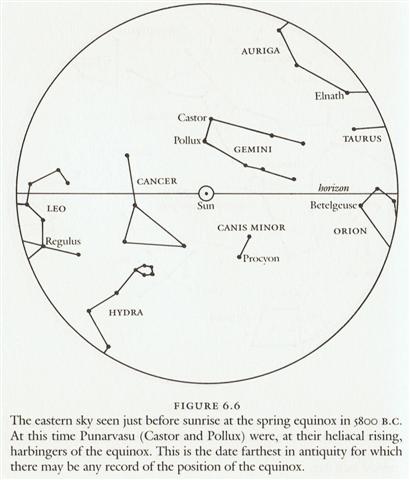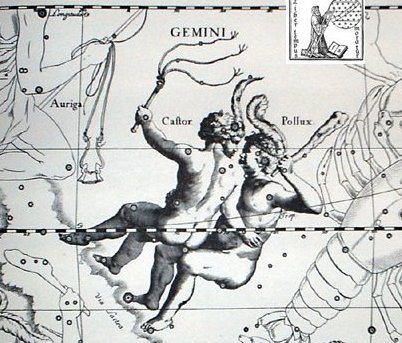425. Once again. The age of Gemini seems to have been the first to stand at the northern spring equinox: ... In Hindu legend there was a mother goddess called Aditi, who had seven offspring. She is called 'Mother of the Gods'. Aditi, whose name means 'free, unbounded, infinity' was assigned in the ancient lists of constellations as the regent of the asterism Punarvasu. Punarvasu is dual in form and means 'The Doublegood Pair'. The singular form of this noun is used to refer to the star Pollux. It is not difficult to surmise that the other member of the Doublegood Pair was Castor. Then the constellation Punarvasu is quite equivalent to our Gemini, the Twins. In far antiquity (5800 B.C.) the spring equinoctial point was predicted by the heliacal rising of the Twins ...
The preceding age of Cancer could have been perceived as ruled by Virgo standing at high summer:
*41.4 + *80 = *121.4 and 121.4 / 365.25 * 26000 was 8642 years before the time of rongorongo. 8642 - 1842 AD = 6800 BC, when the northern vernal equinox had been in Cancer. 12500 BC (cfr the illustration above) - 6800 BC = 5700 years corresponds to 5700 / 26000 * 365.25 = 80 right ascension days, which means that in the age of Cancer (6800 BC) the thong which held it all together would have been around June 9 (80 + 80). The 'Gate of Cancer' (the Sun rising at Praesepe, the Beehive, ε Cancri) could then naturally have referred to the Gate of Gemini: ... Men's spirits were thought to dwell in the Milky Way between incarnations. This conception has been handed down as an Orphic and Pythagorean tradition fitting into the frame of the migration of the soul. Macrobius, who has provided the broadest report on the matter, has it that souls ascend by way of Capricorn, and then, in order to be reborn, descend again through the 'Gate of Cancer'. Macrobius talks of signs; the constellations rising at the solstices in his time (and still in ours) were Gemini and Sagittarius: the 'Gate of Cancer' means Gemini. In fact, he states explicitly (I,12.5) that this 'Gate' is 'where the Zodiac and the Milky Way intersect' ...
9 months - the approximate duration of human pregnancy - after the Sun had reached Spica in Virgo the Gemini twins ought to have been born, viz. in day 3 / 4 * 365.25 = 160 (June 9) + 274 = 434 = 365 + 69 (March 10). *202 (Spica) + *274 - *365 = *111.4 (Propus, ι Gemini) = *41.4 (Bharani) + *70.0.
Propus ought to mean 'before the foot', because the first point in Gemini was out in the Milky Way River before the Sun reached the left foot of Castor (the mortal twin).
|


.jpg)



